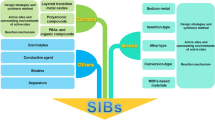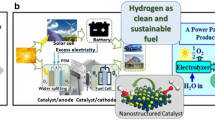Abstract
The models were established for the theoretical current-voltage characteristics in water dissociation process on a bipolar membrane. Particular attention was given to the transport of the water ions and electrolyte ions as well as the membrane physical structure and configuration. The factors on the water splitting process were adequately analysed based on the derived theoretical current-voltage characteristics and several good suggestions were proposed for decreasing the work voltage in practical operations. In addition, the model can give a reasonable explanation for the catalytic effect of some chemicals, such as amphiprotic hydroxide compounds, weak polymeric acids and bases, etc. It is shown that the catalyst may be responsible for the increase in dissociation rate constant of water and therefore enhance the water dissociation. The guidelines for choosing a proper catalyst were also proposed.
Similar content being viewed by others
References
Xu Tongwen, Wang Zhiwu, Liu Ning, Prospect of the theory and application for a bipolar membrane,Water Treatment, 1998, 24(1): 20.
Tsuru, T., Nakao, S., Kimura, S., Ion separation by bipolar membranes in reverse osmosis,J. Membr. Sci., 1995, 108: 269.
Bauer, B., Gerner, F. J., Stratbmann, H., Development of bipolar membranes,Desalination, 1988, 68: 279.
Mani, K. N., Electrodialysis water splitting technology, J.Membr. Sci., 1991, 58: 117.
Onsager, I.., Deviations from Ohm’ s Law in weak electrolytes,J. Chem. Phys., 1934, 2: 599.
Simons, R., Strong electric fields effects on proton transfer between membrane-bound amines and water,Nature, 1979, 280: 824.
Simons, R., Khanarian, G., Water dissociation in bipolar membranes: Experiments and theory,J. Membr. Biol., 1978, 38:ll.
Mafe, S., Manzanares, J. A., Model for ion transport in bipolar membranes,Phys. Rev., A, 1990, 42: 6245.
Ramirez, P., Manzanares, J. A., Mafe, S., Water dissociation effects in ion transport through anionic exchange membranes with thin cationic exchange surface films,Ber. Bunsenges Phys. Chem., 1991, 95(1): 499.
Simons, R., A mechanism for water flow in bipolar memhranes, J.Membr. Sci., 1993, 82: 65.
Gineste, J. L.. Pourcelly, G., Lorrain, Y. et al., Analysis of factors limiting the use of bipolar memhranes: a simplified model to determine trends,J. Membr. Sci., 1996, 112: 199.
Bassignana, I. C., Reiss, H., Ion transport and water dissociation in bipolar ion exchange membranes,J. Membr. Sci., 1983, 15: 27.
Simons, R., Preparation of a high performance bipolar membrane,J.Membr. Sci., 1993, 782: 13.
Mauro, A., Space charge region in fixed charge membranes and the associated property of capacitance,Biophysical J., 1962, 2: 179.
Coster, H. G. L., The double fixed charge membrane,Biophysical J., 1973, 13: 118.
Chilcott, T. C., Coster, H. G. L, George, E. P., AC impedance of the bipolar membrane at low and high frequencies,J.Membr. Sci., 1995, 100: 77.
Coster, H. G. L., A quantitative analysis of the voltage-current relationships of fixed charge memhranes and the associated property of “punch- through”,Biophysical J., 1965, 5: 669.
Strathmann, H., Krol, J. J., Kapp, H. J. et al., Limiting current density and water dissociation in bipolar membranes, J.Membr. Sci., 1997, 125: 123.
Liao Shangzhi, Mo Jianxiong, Experimental study for the production of acid and base by a bipolar membrane process,Water Treatment, 1997, 23(6): 78.
Author information
Authors and Affiliations
Additional information
Project supported by the Youth Foundation of USTC[1999], the Foundation of the State Kay Lab. of Func. Poly. Materials for Adsor. & Sep., Nankai Univ. [1998], the Foundation of Post-doctoral of China (No. 1996(2)) and the National Natural Science Foundation of China (Grand No. 2997604).
Rights and permissions
About this article
Cite this article
Xu, T., Yang, W. & He, B. Water dissociation phenomena in a bipolar membrane. Sc. China Ser. B-Chem. 42, 589–598 (1999). https://doi.org/10.1007/BF02874323
Received:
Issue Date:
DOI: https://doi.org/10.1007/BF02874323




